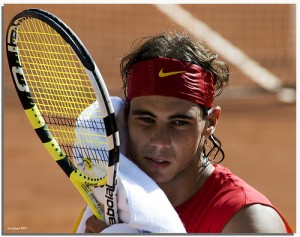
The Madrid Open has begun in earnest and for local favourite Rafa Nadal, in contrast to last year, it could not have come at a more opportune moment both physically and mentally.
At Roland Garros in May 2009, Nadal ceded to Roger Federer the title he had dominated the previous four years, although it was Robin Söderling, in a harbinger of things to come for the now number seven-ranked Swede, who actually dispatched the reigning champion in the fourth round before reaching the final himself.
Last year’s French Open was Nadal’s final tournament until the Montreal Masters in October. World number one at the time and coming off the back of an exceptional run of results – Nadal won the Australian Open, then swept the European clay court circuit clean with wins in Monte-Carlo, Barcelona and Rome – the scene was set for Nadal to triumph in his home capital.
But it was not to be. Nadal reached the final, after a stunning semi-final against Novak Djokovic, but was defeated by Federer in the title match. Unsurprisingly, Federer was the fresher of the two on that occasion. The Swiss beat Juan Martín del Potro comfortably in the first semi-final in 81 minutes, whereas Nadal and Djokovic slugged it out on Center Court well into dusk in a match lasting four hours and three minutes – an Open Era record for a three-set encounter.
Whether that was the draw that broke Nadal’s back is unclear – he had been carrying a niggling knee injury for some time – but it was the precursor to a string of problems that lost the Mallorcan his French Open and Wimbledon crowns, and his number one ranking.
“I came close to breaking,” said Nadal after Roland Garros. “I wanted to play Madrid, but now I think it was a mistake. Since Monte Carlo I hadn’t been performing as I should. I was having the best year of my career until the problems came. I’d been playing almost every day with an anti-inflammatory and I was in too much pain to play well at the tournaments that were important for me: Roland Garros and Wimbledon.”
This year, though, Nadal is back to his bullying best on his favoured surface, coming into the Madrid tournament on the back of wins in Monte Carlo and Rome – his first titles since lifting the trophy in the Italian capital a year earlier. Tellingly, Nadal eschewed the defence of his Barcelona title, which he had held for five years – something inconceivable to the rampaging player of 2009.
“I’m in perfect shape,” Nadal said when he announced his withdrawal from Barcelona, the club where he learned his trade. “I feel very good but I don’t want a repeat of what happened last year. For my tennis to be at the right level, I have to be physically well and that’s my principal objective.”
In his runs to both the 1000-point Masters titles on clay thus far this year, Nadal dropped just one set, in the Rome semi-finals, to Ernests Gulbis, the Latvian who has risen to a career-high world number 35 and captured his first ATP tournament victory at Delray Beach in February.
And neither is the allure of lifting the one European clay court trophy to elude him Nadal’s sole motivation. Should he do so, he will become the first player to win all three Masters 1000 clay-court trophies in the same season, overtake Andre Agassi to become the player with the most Masters wins in the history of the sport, and there is a reasonable chance that the man standing next to him with the consolation plate will be the world number one himself. Nadal’s innate bashfulness in interviews appears as natural as his on-court aggression but there is little doubt that the sight of Federer completing the career slam by lifting the Coupe des Mousquetaires last year was not viewed impassively in the Nadal household.
It was after Madrid last season that Federer famously said: “Maybe a couple of weeks ago I was still a little bit unsure about my game and not sure whether I could win the French Open, but now that’s changed.”
With Djokovic withdrawing from Madrid through injury, Nadal can retake the number two spot and go into the French Open similarly seeded, thus avoiding Federer until the final, should both reach that stage; an extra motivation for the Spaniard in Madrid.
“I haven’t been in form since Monte Carlo, I’ve been in form since January 1,” Nadal told a press conference at the Caja Mágica arena on Sunday. “I’ve been sufficiently in form to have won all the tournaments I’ve played. I should have gone further in Indian Wells, Doha or Australia, which was my worst tournament. But in the important moments I lacked a little bit of calm. Rome and Monte-Carlo gave me that dose of calm that I needed.”
Leave a Reply
You must be logged in to post a comment.